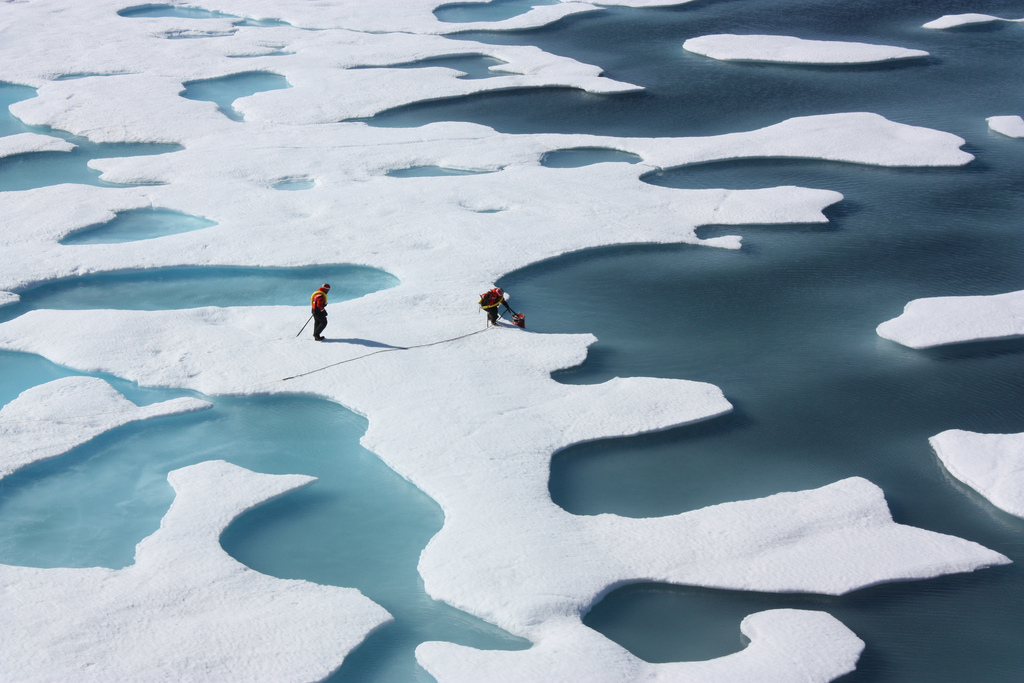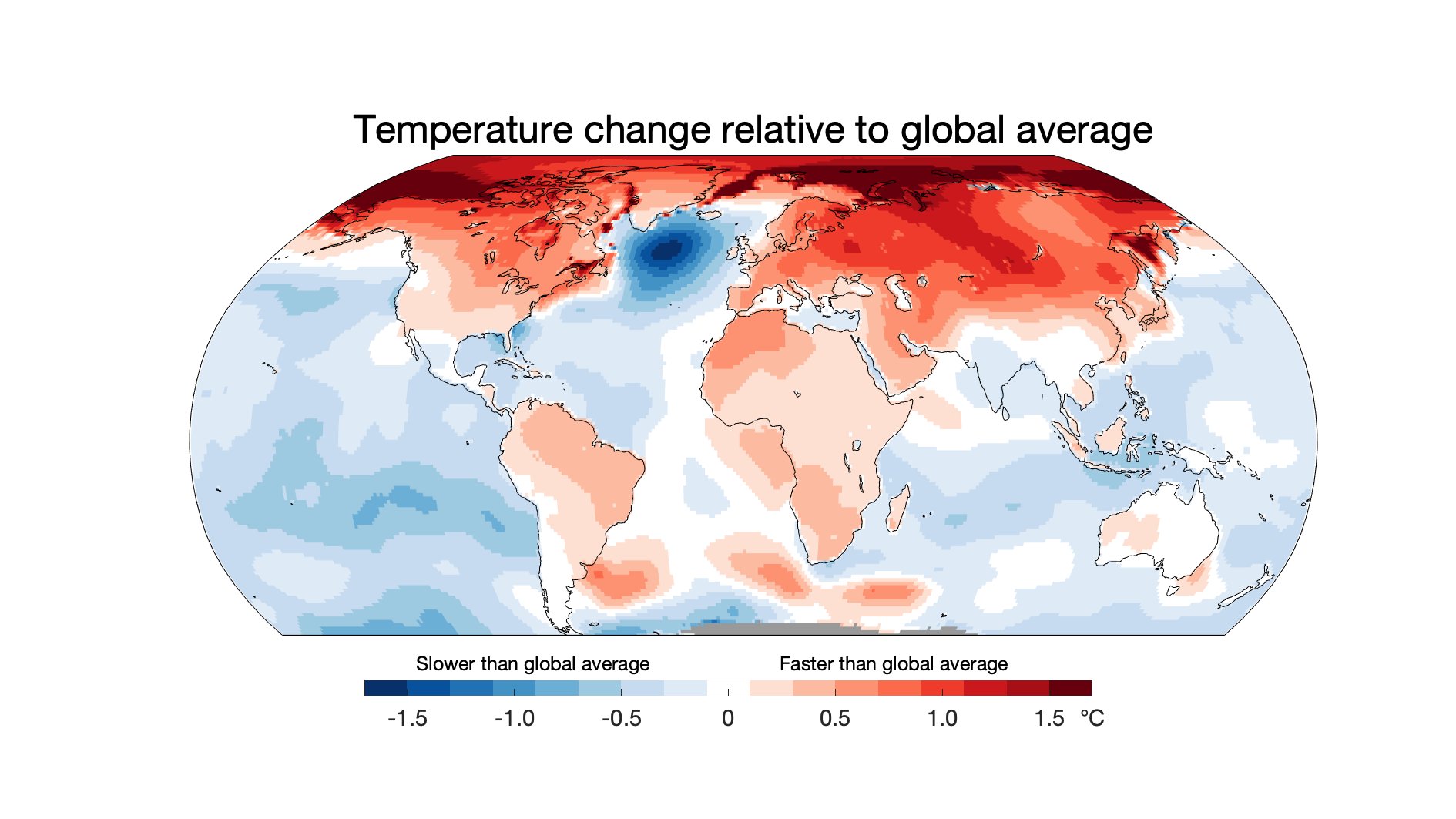
If you’re even a casual consumer of climate news, you probably know that some parts of the globe are warming more rapidly than others. Scientists have known for years, for instance, that the Arctic is heating up at a faster clip than the global average, and recently, the region made headlines after a study showed that the northernmost reaches of our planet are warming four times faster than the rest of the Earth.[1]
But as data continue to show that several regions – Australia, the Arctic, and the Middle East included – warm more quickly than the planetary average, some commentators have developed a narrative that these findings are evidence that climate science can’t be trusted. “Here’s a question to ponder,” the Daily Caller noted in an August op-ed, “If everything is warming faster than everywhere else, is anything warming faster, or is it all bogus?”
This narrative, as we’ll show below, is based on flawed reasoning. The scientific underpinnings of why some regions of the world warm more quickly than others are strong, and have a lot to do with the global ocean, geography, and – especially in the case of the Earth’s poles – the feedback loop between melting ice and further warming.
“Our understanding of how different surfaces warm up and retain heat means we expect different regions to warm more quickly than others,” said Linden Ashcroft, a climate scientist and lecturer at the University of Melbourne, Australia.
What is the global average rate of warming?
The first thing to understand about the global average rate of warming – the baseline that locations such as the Arctic and Australia are surpassing – is that it includes the warming rate of land masses as well as the global ocean. That’s important, because when it comes to human-caused warming, the ocean warms more slowly than land – which is part of the reason so many land masses heat up more quickly than the global average.
“Water, in terms of its physical property, is a really hard thing to warm up,” said Adam Schlosser, senior research scientist at the Center for Global Change Science at MIT. “It takes more energy to warm up an equivalent mass of water than it does to warm up the equivalent mass of soil. So because of that mere physical fact, we see major landmass areas warming faster than ocean areas.”
This phenomenon is known as “Cooler Ocean, Warmer Land,” or COWL. It’s a well-understood concept in climate science, Schlosser said, and helps explain why several regions of the world are heating up more quickly than the global average. The slow speed at which the ocean warms is pulling down the Earth’s overall warming rate, making it easier for land masses to warm more quickly than average.
Figure 1: Graphic shows which parts of the planet are warming faster, and which are warming slower, than average. Much of the ocean, particularly in the subpolar North Atlantic below Greenland, is warming slower than average, while many land masses are warming more quickly. Image created by Ed Hawkins, climate science professor at the University of Reading; image sent courtesy Jennifer Francis.
According to the National Oceanic and Atmospheric Administration, the planet’s “combined land and ocean temperature has increased at an average rate of 0.14 degrees Fahrenheit (0.08 degrees Celsius) per decade since 1880; however, the average rate of increase since 1981 (0.18°C / 0.32°F) has been more than twice that rate.” Scientists determine this average rate of warming by analyzing temperature measurements taken from locations all around the world – from ships, buoys, weather balloons, weather stations and more – and compare each location’s temperature over a given time period to that location’s long-term average temperature.
“Observations from all over the Earth are first quality checked, then the measurements are averaged for each time period (day, week, month, year, etc),” Jennifer Francis, acting deputy director at Woodwell Climate Research Center, said. “Trends in those values are calculated, producing the global average temperature change.”
Scientists use a similar method to determine how quickly individual regions are warming, using long-term, quality-checked temperature data from weather stations in the region they’re focusing on. That quality-checking is important, Ashcroft said.
“The data are closely examined for any changes that may be due to non-climatic things, such as movement of weather stations, replacement of instruments, or a change in the environment around the weather station (e.g. the growing of nearby trees or buildings going up),” she said. “A long-term temperature dataset then allows us to look at temperature trends in a region, and how those trends might be changing.”
These careful measurements allow scientists to determine a region’s average rate of warming, then compare it to the Earth as a whole. They also allow scientists to determine which regions are warming faster than average, and which have temperature records that are relatively flat or, in some cases, even cooling slightly. In spite of these regional differences, the overall temperature of the planet has been trending upwards for the last several decades.
Figure 2: Yearly surface temperature compared to the 20th-century average from 1880–2021. Blue bars indicate cooler-than-average years; red bars show warmer-than-average years. NOAA Climate.gov caption and graph, based on data from the National Centers for Environmental Information.
The other reasons why some regions warm at different rates
The ocean pulling down the planetary average rate of warming provides a background for many land masses warming more quickly than average, but it’s not the only reason for the differences in warming speed from place to place. Scientists know, for instance, that human-caused warming is amplified at the poles. Part of the reason for this is the albedo effect: as warming ocean and air temperatures cause polar ice to melt, it exposes the region to more dark, heat-absorbing water, and less energy-reflecting white ice, further exacerbating warming.
“You replace a very reflective surface with a very absorptive surface,” Schlosser said. “That feeds back, and the energy from the sun that would have been reflected gets absorbed and amplifies the warming.”
Arctic warming is also exacerbated by the region’s lack of atmospheric convection – the process, as Carbon Brief explains, by which the earth’s surface heats the air closest to it, causing the warm air to rise and mix with higher air layers. That process is common in the tropics, but less common in the cold Arctic, which makes Arctic air less mixed and leads to stronger warming near the surface of the Arctic. The region’s warming is also affected by the movement of water vapor from the tropics to the poles.[2][6]
“We understand the physics in terms of the energy balance, and what happens at the higher latitudes is that imbalance is amplified, in terms of gases that barricade the ability for earth to re-emit energy back into space,” Schlosser said.
But what about locations like the Middle East, which aren’t home to ice and snow and aren’t located at high latitudes? Is the ocean’s slow warming trend the only thing to blame for these location’s comparatively speedy temperature rise?
No – in fact, there are several locality-specific reasons why a location might warm more quickly than others. For the Middle East, geography is a big one: the region is home to vast expanses of desert. That means it gets little cooling help from water evaporating from trees and other vegetation, which research has shown can slow down warming.[3] Phenomena like localized pollution, deforestation and urbanization, and the urban heat island effect can also cause a location to warm more quickly than average.
A false choice
The narrative that these differences in warming rates shed doubt on climate science has been around for several years. In 2010, for instance, blogger and Heartland Institute affiliate Anthony Watts referenced claims similar to the Daily Caller’s on his blog Watts Up With That (Science Feedback has reviewed several false claims from Watts’ blog throughout the years).
Ashcroft said the claim that different rates of warming in different regions of the planet casts doubt on the veracity of climate science is a false choice – a misinformation technique that limits choices to only two possibilities, ignoring other options.
“The argument seems to be based on the idea that both pieces of information (global temperature increases, and regional temperature increases that are different) cannot be true, when in fact they are,” she said. “It also seems to be an attempt to cast doubt on the reliability of climate research and demanding impossible expectations of no uncertainty before action is required, two other common science denial techniques.”
Scientists have long known that the warming of the planet is not uniform.[4] But rather than cast doubt on the validity of climate science, the findings that different regions of the planet warm at different rates support climate scientists’ predictions, based on their understanding of the earth system. And though regional warming trends differ, the Earth’s overall temperature trend has been increasing over the last several decades, with other clues – melting glaciers, retreating sea ice, changes in the ranges of plants and animals – also painting a clear picture of warming.[5]
“We are now seeing record-breaking heat events in many countries every year, which are repeatedly shown to be made worse, or more likely, because of climate change,” Ashcroft said. “Perhaps the increased reporting of increasing heat extremes means this kind of illogical argument is appealing to some.”
References
- [1] Rantanen et al. (2022) The Arctic has warmed nearly four times faster than the globe since 1979. Nature Communications Earth and Environment.
- [2] Previdi et al. (2021) Arctic amplification of climate change: a review of underlying mechanisms. Environmental Research Letters.
- [3] Ban-Weiss et al. (2014) Climate forcing and response to idealized changes in surface latent and sensible heat. Environmental Research Letters.
- [4] Ji et al. (2014) Evolution of land surface air temperature trend. Nature Climate Change.
- [5] IPCC (2022) Climate Change 2022: Impacts, Adaptation and Vulnerability. Contributions of Working Group II to the Sixth Assessment Report of the Intergovernmental Panel on Climate Change.
- [6] Pithan et al. (2014) Arctic amplification dominated by temperature feedbacks in contemporary climate models. Nature Geoscience.



